Analyzing Fila's Organizational Structure for Business Development
VerifiedAdded on 2022/01/17
|9
|2811
|178
Report
AI Summary
This report provides a comprehensive analysis of Fila Holdings Corp., a South Korean sportswear company, examining its industry position, organizational structure, and business model. It begins with an overview of Fila's history and evolution, from its origins as an underwear manufacturer in Italy to its current status as a global sportswear brand. The report identifies different types of organizations, including sole proprietorships, partnerships, corporations, and public/private sectors, and then delves into Fila's governing bodies, services, and products. Key stakeholders and the objectives driving Fila's operations are also discussed. The organizational structure, based on a matrix model, is dissected, highlighting the roles of marketing, human resources, finance, production, engineering, and projects departments. Furthermore, the report explores Fila's business modeling, focusing on marketing strategies, financing approaches, and human resources management, and concludes by examining the relationships between various organizational functions and how they contribute to the company's overall objectives and structure.
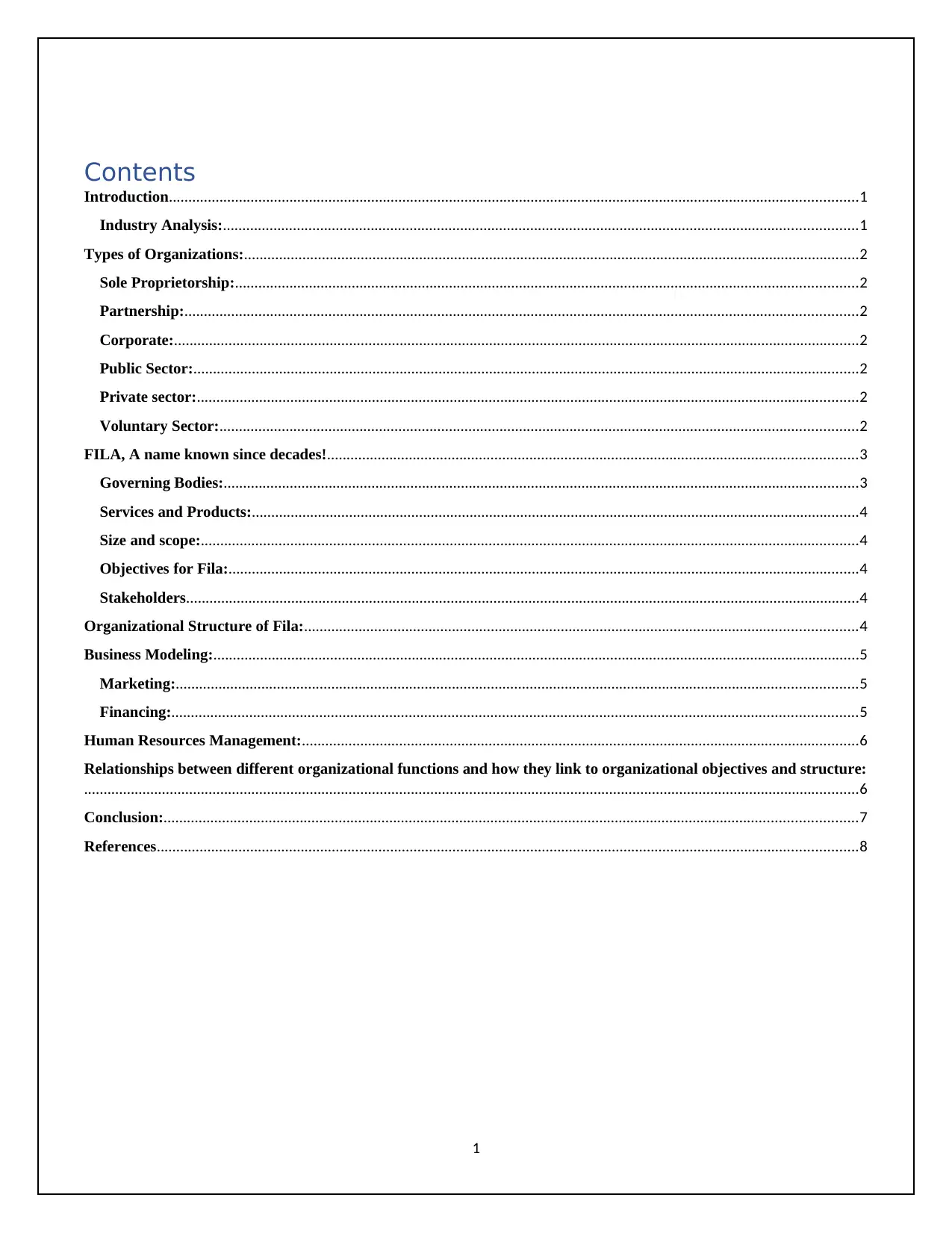
Contents
Introduction.................................................................................................................................................................................1
Industry Analysis:...................................................................................................................................................................1
Types of Organizations:..............................................................................................................................................................2
Sole Proprietorship:................................................................................................................................................................2
Partnership:.............................................................................................................................................................................2
Corporate:................................................................................................................................................................................2
Public Sector:...........................................................................................................................................................................2
Private sector:..........................................................................................................................................................................2
Voluntary Sector:....................................................................................................................................................................2
FILA, A name known since decades!........................................................................................................................................3
Governing Bodies:...................................................................................................................................................................3
Services and Products:............................................................................................................................................................4
Size and scope:.........................................................................................................................................................................4
Objectives for Fila:..................................................................................................................................................................4
Stakeholders.............................................................................................................................................................................4
Organizational Structure of Fila:..............................................................................................................................................4
Business Modeling:......................................................................................................................................................................5
Marketing:...............................................................................................................................................................................5
Financing:................................................................................................................................................................................5
Human Resources Management:...............................................................................................................................................6
Relationships between different organizational functions and how they link to organizational objectives and structure:
.......................................................................................................................................................................................................6
Conclusion:..................................................................................................................................................................................7
References....................................................................................................................................................................................8
1
Introduction.................................................................................................................................................................................1
Industry Analysis:...................................................................................................................................................................1
Types of Organizations:..............................................................................................................................................................2
Sole Proprietorship:................................................................................................................................................................2
Partnership:.............................................................................................................................................................................2
Corporate:................................................................................................................................................................................2
Public Sector:...........................................................................................................................................................................2
Private sector:..........................................................................................................................................................................2
Voluntary Sector:....................................................................................................................................................................2
FILA, A name known since decades!........................................................................................................................................3
Governing Bodies:...................................................................................................................................................................3
Services and Products:............................................................................................................................................................4
Size and scope:.........................................................................................................................................................................4
Objectives for Fila:..................................................................................................................................................................4
Stakeholders.............................................................................................................................................................................4
Organizational Structure of Fila:..............................................................................................................................................4
Business Modeling:......................................................................................................................................................................5
Marketing:...............................................................................................................................................................................5
Financing:................................................................................................................................................................................5
Human Resources Management:...............................................................................................................................................6
Relationships between different organizational functions and how they link to organizational objectives and structure:
.......................................................................................................................................................................................................6
Conclusion:..................................................................................................................................................................................7
References....................................................................................................................................................................................8
1
Paraphrase This Document
Need a fresh take? Get an instant paraphrase of this document with our AI Paraphraser
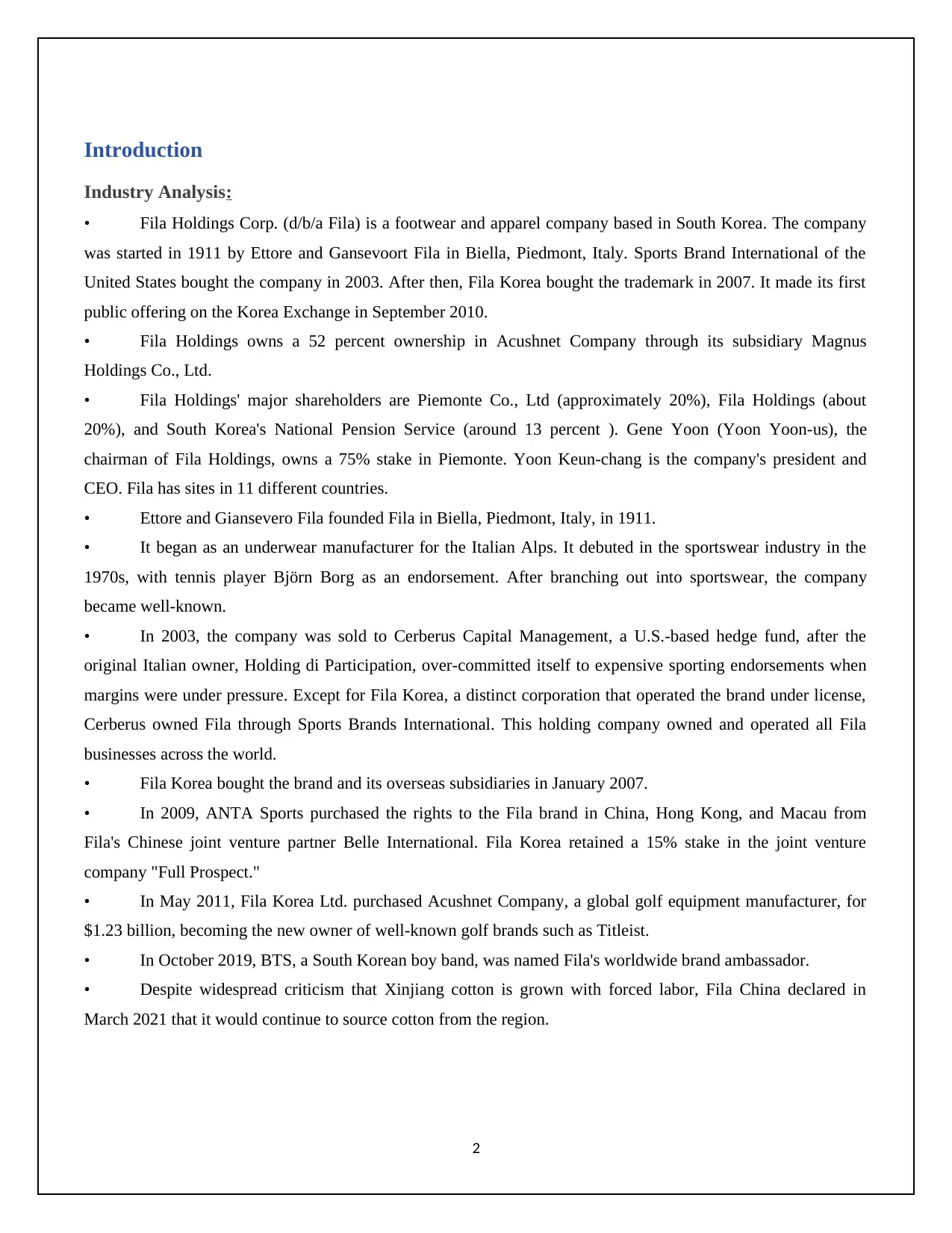
Introduction
Industry Analysis:
• Fila Holdings Corp. (d/b/a Fila) is a footwear and apparel company based in South Korea. The company
was started in 1911 by Ettore and Gansevoort Fila in Biella, Piedmont, Italy. Sports Brand International of the
United States bought the company in 2003. After then, Fila Korea bought the trademark in 2007. It made its first
public offering on the Korea Exchange in September 2010.
• Fila Holdings owns a 52 percent ownership in Acushnet Company through its subsidiary Magnus
Holdings Co., Ltd.
• Fila Holdings' major shareholders are Piemonte Co., Ltd (approximately 20%), Fila Holdings (about
20%), and South Korea's National Pension Service (around 13 percent ). Gene Yoon (Yoon Yoon-us), the
chairman of Fila Holdings, owns a 75% stake in Piemonte. Yoon Keun-chang is the company's president and
CEO. Fila has sites in 11 different countries.
• Ettore and Giansevero Fila founded Fila in Biella, Piedmont, Italy, in 1911.
• It began as an underwear manufacturer for the Italian Alps. It debuted in the sportswear industry in the
1970s, with tennis player Björn Borg as an endorsement. After branching out into sportswear, the company
became well-known.
• In 2003, the company was sold to Cerberus Capital Management, a U.S.-based hedge fund, after the
original Italian owner, Holding di Participation, over-committed itself to expensive sporting endorsements when
margins were under pressure. Except for Fila Korea, a distinct corporation that operated the brand under license,
Cerberus owned Fila through Sports Brands International. This holding company owned and operated all Fila
businesses across the world.
• Fila Korea bought the brand and its overseas subsidiaries in January 2007.
• In 2009, ANTA Sports purchased the rights to the Fila brand in China, Hong Kong, and Macau from
Fila's Chinese joint venture partner Belle International. Fila Korea retained a 15% stake in the joint venture
company "Full Prospect."
• In May 2011, Fila Korea Ltd. purchased Acushnet Company, a global golf equipment manufacturer, for
$1.23 billion, becoming the new owner of well-known golf brands such as Titleist.
• In October 2019, BTS, a South Korean boy band, was named Fila's worldwide brand ambassador.
• Despite widespread criticism that Xinjiang cotton is grown with forced labor, Fila China declared in
March 2021 that it would continue to source cotton from the region.
2
Industry Analysis:
• Fila Holdings Corp. (d/b/a Fila) is a footwear and apparel company based in South Korea. The company
was started in 1911 by Ettore and Gansevoort Fila in Biella, Piedmont, Italy. Sports Brand International of the
United States bought the company in 2003. After then, Fila Korea bought the trademark in 2007. It made its first
public offering on the Korea Exchange in September 2010.
• Fila Holdings owns a 52 percent ownership in Acushnet Company through its subsidiary Magnus
Holdings Co., Ltd.
• Fila Holdings' major shareholders are Piemonte Co., Ltd (approximately 20%), Fila Holdings (about
20%), and South Korea's National Pension Service (around 13 percent ). Gene Yoon (Yoon Yoon-us), the
chairman of Fila Holdings, owns a 75% stake in Piemonte. Yoon Keun-chang is the company's president and
CEO. Fila has sites in 11 different countries.
• Ettore and Giansevero Fila founded Fila in Biella, Piedmont, Italy, in 1911.
• It began as an underwear manufacturer for the Italian Alps. It debuted in the sportswear industry in the
1970s, with tennis player Björn Borg as an endorsement. After branching out into sportswear, the company
became well-known.
• In 2003, the company was sold to Cerberus Capital Management, a U.S.-based hedge fund, after the
original Italian owner, Holding di Participation, over-committed itself to expensive sporting endorsements when
margins were under pressure. Except for Fila Korea, a distinct corporation that operated the brand under license,
Cerberus owned Fila through Sports Brands International. This holding company owned and operated all Fila
businesses across the world.
• Fila Korea bought the brand and its overseas subsidiaries in January 2007.
• In 2009, ANTA Sports purchased the rights to the Fila brand in China, Hong Kong, and Macau from
Fila's Chinese joint venture partner Belle International. Fila Korea retained a 15% stake in the joint venture
company "Full Prospect."
• In May 2011, Fila Korea Ltd. purchased Acushnet Company, a global golf equipment manufacturer, for
$1.23 billion, becoming the new owner of well-known golf brands such as Titleist.
• In October 2019, BTS, a South Korean boy band, was named Fila's worldwide brand ambassador.
• Despite widespread criticism that Xinjiang cotton is grown with forced labor, Fila China declared in
March 2021 that it would continue to source cotton from the region.
2
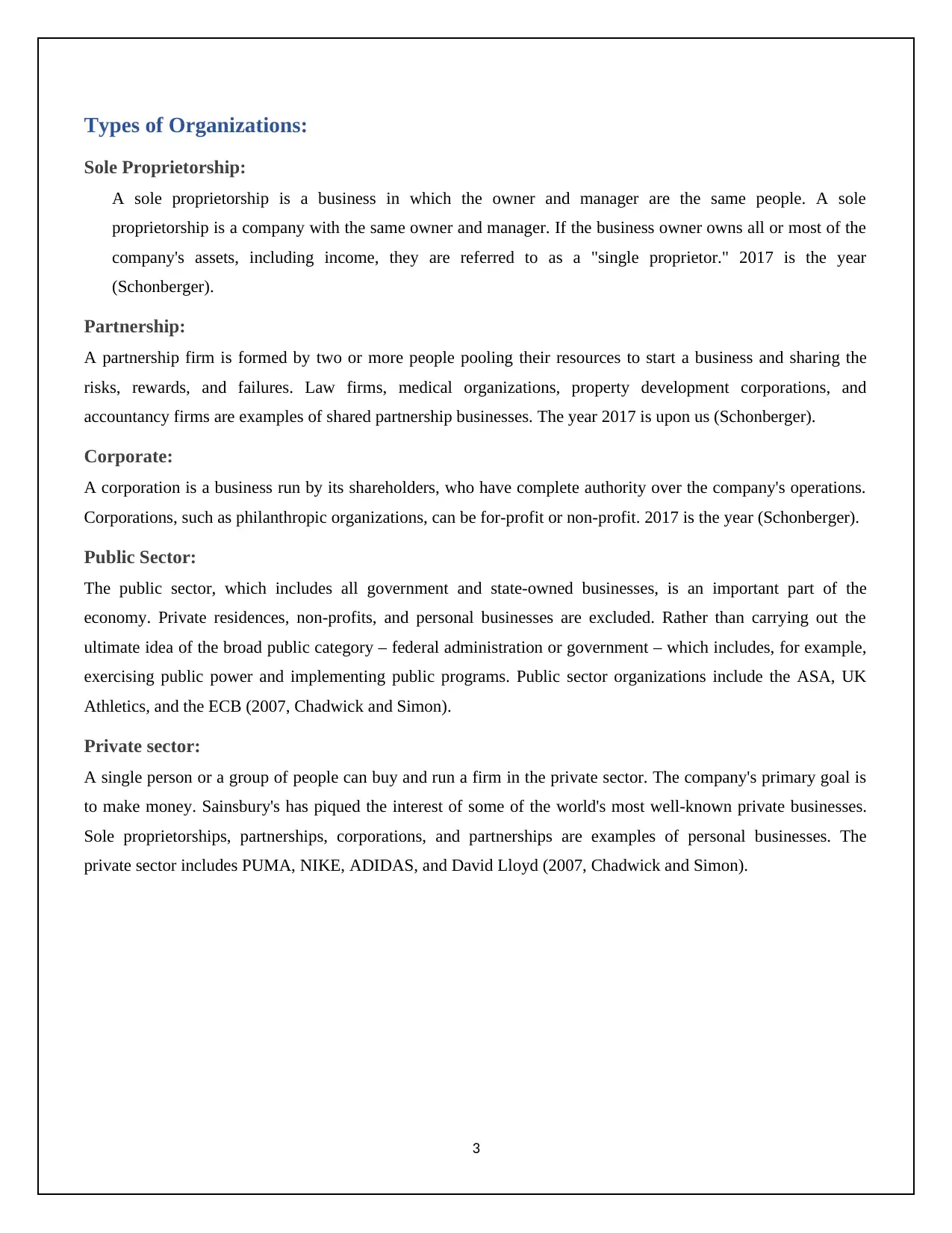
Types of Organizations:
Sole Proprietorship:
A sole proprietorship is a business in which the owner and manager are the same people. A sole
proprietorship is a company with the same owner and manager. If the business owner owns all or most of the
company's assets, including income, they are referred to as a "single proprietor." 2017 is the year
(Schonberger).
Partnership:
A partnership firm is formed by two or more people pooling their resources to start a business and sharing the
risks, rewards, and failures. Law firms, medical organizations, property development corporations, and
accountancy firms are examples of shared partnership businesses. The year 2017 is upon us (Schonberger).
Corporate:
A corporation is a business run by its shareholders, who have complete authority over the company's operations.
Corporations, such as philanthropic organizations, can be for-profit or non-profit. 2017 is the year (Schonberger).
Public Sector:
The public sector, which includes all government and state-owned businesses, is an important part of the
economy. Private residences, non-profits, and personal businesses are excluded. Rather than carrying out the
ultimate idea of the broad public category – federal administration or government – which includes, for example,
exercising public power and implementing public programs. Public sector organizations include the ASA, UK
Athletics, and the ECB (2007, Chadwick and Simon).
Private sector:
A single person or a group of people can buy and run a firm in the private sector. The company's primary goal is
to make money. Sainsbury's has piqued the interest of some of the world's most well-known private businesses.
Sole proprietorships, partnerships, corporations, and partnerships are examples of personal businesses. The
private sector includes PUMA, NIKE, ADIDAS, and David Lloyd (2007, Chadwick and Simon).
3
Sole Proprietorship:
A sole proprietorship is a business in which the owner and manager are the same people. A sole
proprietorship is a company with the same owner and manager. If the business owner owns all or most of the
company's assets, including income, they are referred to as a "single proprietor." 2017 is the year
(Schonberger).
Partnership:
A partnership firm is formed by two or more people pooling their resources to start a business and sharing the
risks, rewards, and failures. Law firms, medical organizations, property development corporations, and
accountancy firms are examples of shared partnership businesses. The year 2017 is upon us (Schonberger).
Corporate:
A corporation is a business run by its shareholders, who have complete authority over the company's operations.
Corporations, such as philanthropic organizations, can be for-profit or non-profit. 2017 is the year (Schonberger).
Public Sector:
The public sector, which includes all government and state-owned businesses, is an important part of the
economy. Private residences, non-profits, and personal businesses are excluded. Rather than carrying out the
ultimate idea of the broad public category – federal administration or government – which includes, for example,
exercising public power and implementing public programs. Public sector organizations include the ASA, UK
Athletics, and the ECB (2007, Chadwick and Simon).
Private sector:
A single person or a group of people can buy and run a firm in the private sector. The company's primary goal is
to make money. Sainsbury's has piqued the interest of some of the world's most well-known private businesses.
Sole proprietorships, partnerships, corporations, and partnerships are examples of personal businesses. The
private sector includes PUMA, NIKE, ADIDAS, and David Lloyd (2007, Chadwick and Simon).
3
⊘ This is a preview!⊘
Do you want full access?
Subscribe today to unlock all pages.

Trusted by 1+ million students worldwide
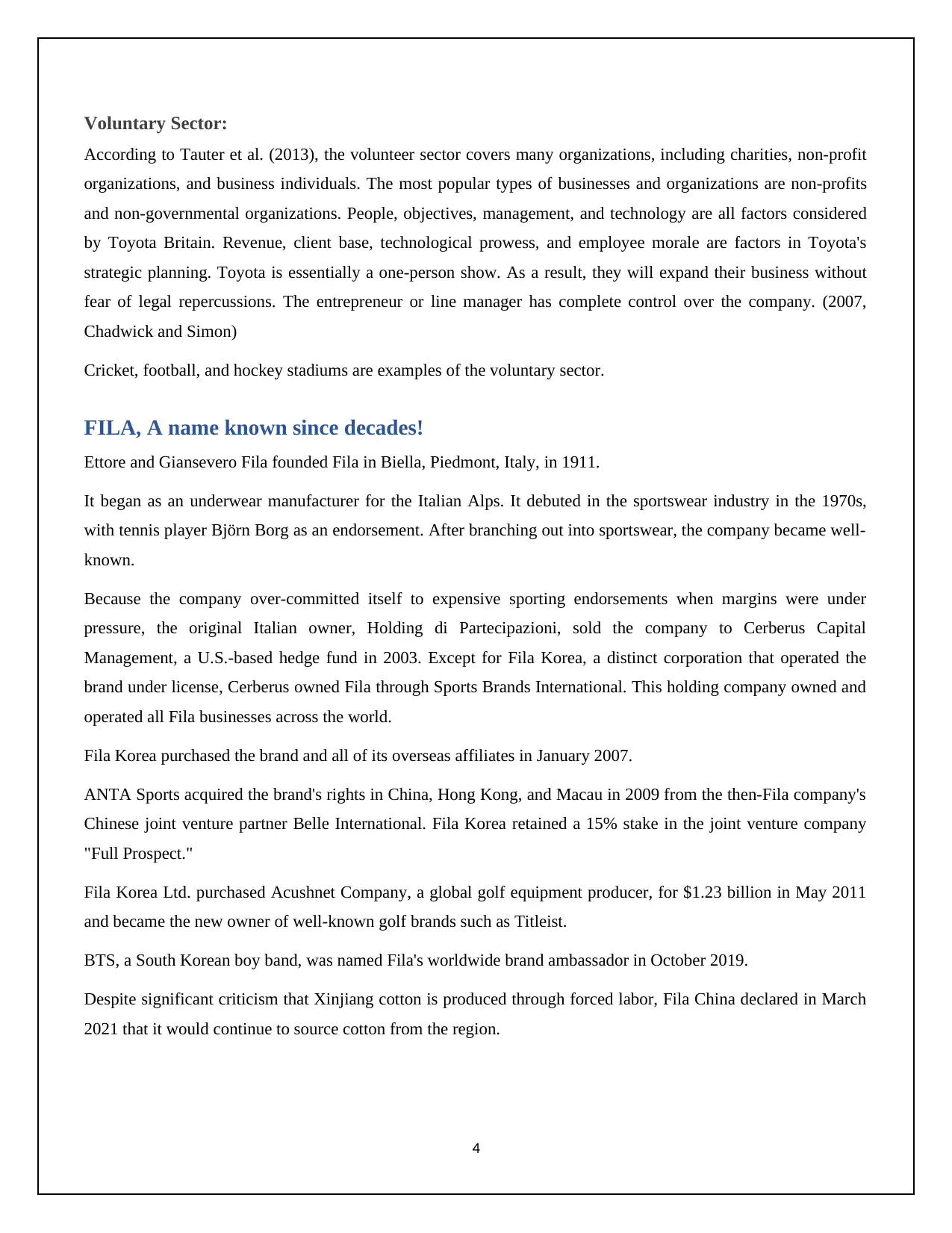
Voluntary Sector:
According to Tauter et al. (2013), the volunteer sector covers many organizations, including charities, non-profit
organizations, and business individuals. The most popular types of businesses and organizations are non-profits
and non-governmental organizations. People, objectives, management, and technology are all factors considered
by Toyota Britain. Revenue, client base, technological prowess, and employee morale are factors in Toyota's
strategic planning. Toyota is essentially a one-person show. As a result, they will expand their business without
fear of legal repercussions. The entrepreneur or line manager has complete control over the company. (2007,
Chadwick and Simon)
Cricket, football, and hockey stadiums are examples of the voluntary sector.
FILA, A name known since decades!
Ettore and Giansevero Fila founded Fila in Biella, Piedmont, Italy, in 1911.
It began as an underwear manufacturer for the Italian Alps. It debuted in the sportswear industry in the 1970s,
with tennis player Björn Borg as an endorsement. After branching out into sportswear, the company became well-
known.
Because the company over-committed itself to expensive sporting endorsements when margins were under
pressure, the original Italian owner, Holding di Partecipazioni, sold the company to Cerberus Capital
Management, a U.S.-based hedge fund in 2003. Except for Fila Korea, a distinct corporation that operated the
brand under license, Cerberus owned Fila through Sports Brands International. This holding company owned and
operated all Fila businesses across the world.
Fila Korea purchased the brand and all of its overseas affiliates in January 2007.
ANTA Sports acquired the brand's rights in China, Hong Kong, and Macau in 2009 from the then-Fila company's
Chinese joint venture partner Belle International. Fila Korea retained a 15% stake in the joint venture company
"Full Prospect."
Fila Korea Ltd. purchased Acushnet Company, a global golf equipment producer, for $1.23 billion in May 2011
and became the new owner of well-known golf brands such as Titleist.
BTS, a South Korean boy band, was named Fila's worldwide brand ambassador in October 2019.
Despite significant criticism that Xinjiang cotton is produced through forced labor, Fila China declared in March
2021 that it would continue to source cotton from the region.
4
According to Tauter et al. (2013), the volunteer sector covers many organizations, including charities, non-profit
organizations, and business individuals. The most popular types of businesses and organizations are non-profits
and non-governmental organizations. People, objectives, management, and technology are all factors considered
by Toyota Britain. Revenue, client base, technological prowess, and employee morale are factors in Toyota's
strategic planning. Toyota is essentially a one-person show. As a result, they will expand their business without
fear of legal repercussions. The entrepreneur or line manager has complete control over the company. (2007,
Chadwick and Simon)
Cricket, football, and hockey stadiums are examples of the voluntary sector.
FILA, A name known since decades!
Ettore and Giansevero Fila founded Fila in Biella, Piedmont, Italy, in 1911.
It began as an underwear manufacturer for the Italian Alps. It debuted in the sportswear industry in the 1970s,
with tennis player Björn Borg as an endorsement. After branching out into sportswear, the company became well-
known.
Because the company over-committed itself to expensive sporting endorsements when margins were under
pressure, the original Italian owner, Holding di Partecipazioni, sold the company to Cerberus Capital
Management, a U.S.-based hedge fund in 2003. Except for Fila Korea, a distinct corporation that operated the
brand under license, Cerberus owned Fila through Sports Brands International. This holding company owned and
operated all Fila businesses across the world.
Fila Korea purchased the brand and all of its overseas affiliates in January 2007.
ANTA Sports acquired the brand's rights in China, Hong Kong, and Macau in 2009 from the then-Fila company's
Chinese joint venture partner Belle International. Fila Korea retained a 15% stake in the joint venture company
"Full Prospect."
Fila Korea Ltd. purchased Acushnet Company, a global golf equipment producer, for $1.23 billion in May 2011
and became the new owner of well-known golf brands such as Titleist.
BTS, a South Korean boy band, was named Fila's worldwide brand ambassador in October 2019.
Despite significant criticism that Xinjiang cotton is produced through forced labor, Fila China declared in March
2021 that it would continue to source cotton from the region.
4
Paraphrase This Document
Need a fresh take? Get an instant paraphrase of this document with our AI Paraphraser
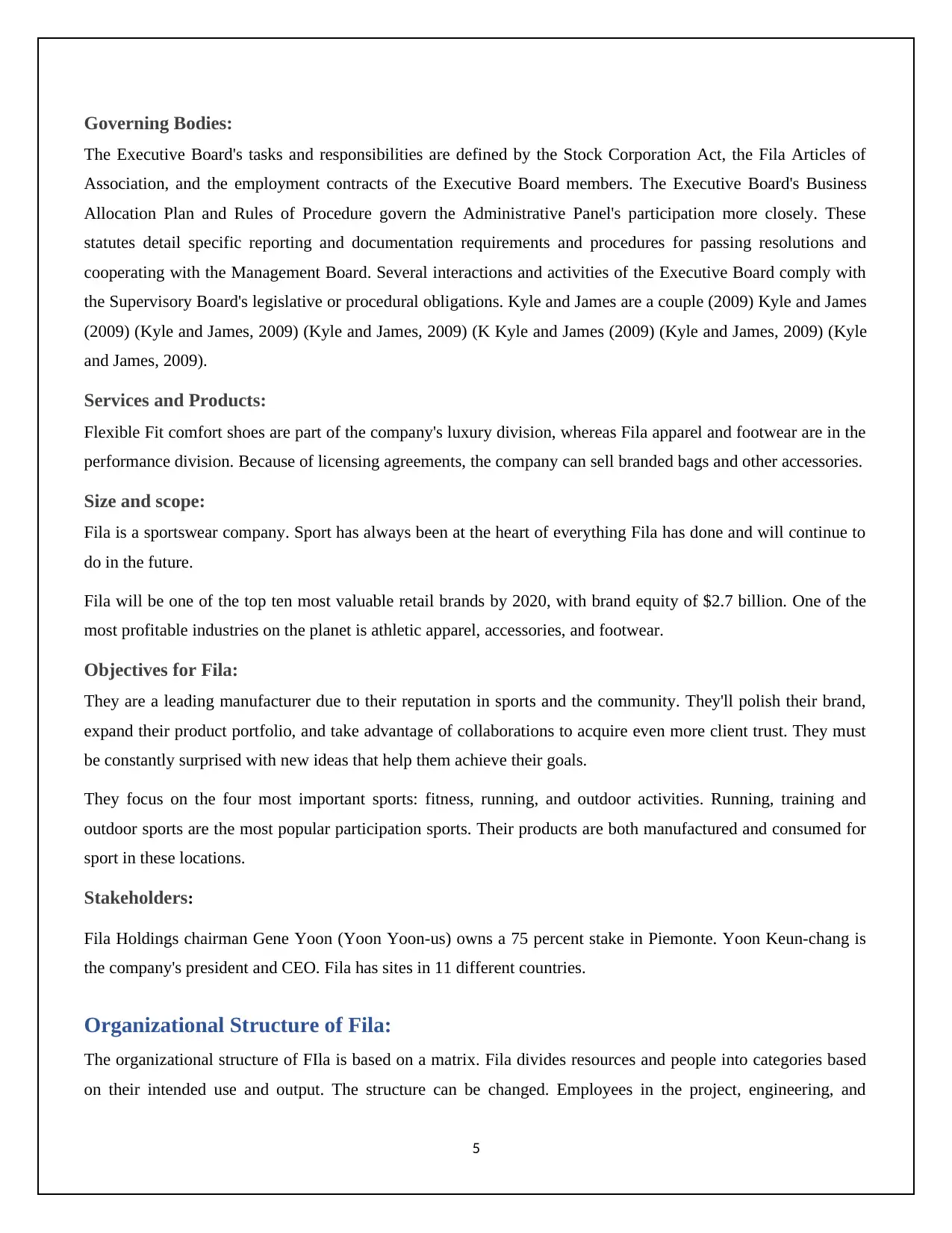
Governing Bodies:
The Executive Board's tasks and responsibilities are defined by the Stock Corporation Act, the Fila Articles of
Association, and the employment contracts of the Executive Board members. The Executive Board's Business
Allocation Plan and Rules of Procedure govern the Administrative Panel's participation more closely. These
statutes detail specific reporting and documentation requirements and procedures for passing resolutions and
cooperating with the Management Board. Several interactions and activities of the Executive Board comply with
the Supervisory Board's legislative or procedural obligations. Kyle and James are a couple (2009) Kyle and James
(2009) (Kyle and James, 2009) (Kyle and James, 2009) (K Kyle and James (2009) (Kyle and James, 2009) (Kyle
and James, 2009).
Services and Products:
Flexible Fit comfort shoes are part of the company's luxury division, whereas Fila apparel and footwear are in the
performance division. Because of licensing agreements, the company can sell branded bags and other accessories.
Size and scope:
Fila is a sportswear company. Sport has always been at the heart of everything Fila has done and will continue to
do in the future.
Fila will be one of the top ten most valuable retail brands by 2020, with brand equity of $2.7 billion. One of the
most profitable industries on the planet is athletic apparel, accessories, and footwear.
Objectives for Fila:
They are a leading manufacturer due to their reputation in sports and the community. They'll polish their brand,
expand their product portfolio, and take advantage of collaborations to acquire even more client trust. They must
be constantly surprised with new ideas that help them achieve their goals.
They focus on the four most important sports: fitness, running, and outdoor activities. Running, training and
outdoor sports are the most popular participation sports. Their products are both manufactured and consumed for
sport in these locations.
Stakeholders:
Fila Holdings chairman Gene Yoon (Yoon Yoon-us) owns a 75 percent stake in Piemonte. Yoon Keun-chang is
the company's president and CEO. Fila has sites in 11 different countries.
Organizational Structure of Fila:
The organizational structure of FIla is based on a matrix. Fila divides resources and people into categories based
on their intended use and output. The structure can be changed. Employees in the project, engineering, and
5
The Executive Board's tasks and responsibilities are defined by the Stock Corporation Act, the Fila Articles of
Association, and the employment contracts of the Executive Board members. The Executive Board's Business
Allocation Plan and Rules of Procedure govern the Administrative Panel's participation more closely. These
statutes detail specific reporting and documentation requirements and procedures for passing resolutions and
cooperating with the Management Board. Several interactions and activities of the Executive Board comply with
the Supervisory Board's legislative or procedural obligations. Kyle and James are a couple (2009) Kyle and James
(2009) (Kyle and James, 2009) (Kyle and James, 2009) (K Kyle and James (2009) (Kyle and James, 2009) (Kyle
and James, 2009).
Services and Products:
Flexible Fit comfort shoes are part of the company's luxury division, whereas Fila apparel and footwear are in the
performance division. Because of licensing agreements, the company can sell branded bags and other accessories.
Size and scope:
Fila is a sportswear company. Sport has always been at the heart of everything Fila has done and will continue to
do in the future.
Fila will be one of the top ten most valuable retail brands by 2020, with brand equity of $2.7 billion. One of the
most profitable industries on the planet is athletic apparel, accessories, and footwear.
Objectives for Fila:
They are a leading manufacturer due to their reputation in sports and the community. They'll polish their brand,
expand their product portfolio, and take advantage of collaborations to acquire even more client trust. They must
be constantly surprised with new ideas that help them achieve their goals.
They focus on the four most important sports: fitness, running, and outdoor activities. Running, training and
outdoor sports are the most popular participation sports. Their products are both manufactured and consumed for
sport in these locations.
Stakeholders:
Fila Holdings chairman Gene Yoon (Yoon Yoon-us) owns a 75 percent stake in Piemonte. Yoon Keun-chang is
the company's president and CEO. Fila has sites in 11 different countries.
Organizational Structure of Fila:
The organizational structure of FIla is based on a matrix. Fila divides resources and people into categories based
on their intended use and output. The structure can be changed. Employees in the project, engineering, and
5
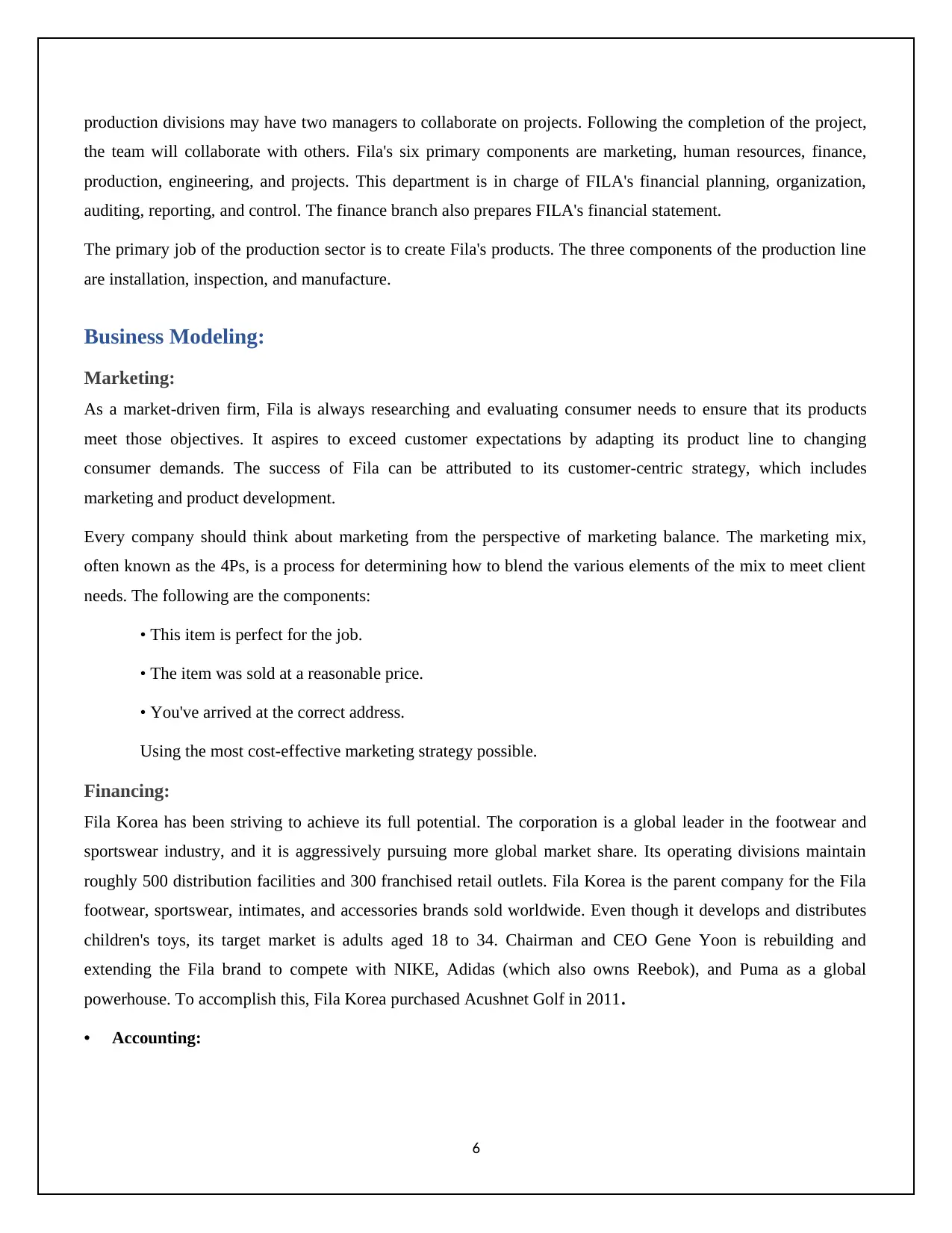
production divisions may have two managers to collaborate on projects. Following the completion of the project,
the team will collaborate with others. Fila's six primary components are marketing, human resources, finance,
production, engineering, and projects. This department is in charge of FILA's financial planning, organization,
auditing, reporting, and control. The finance branch also prepares FILA's financial statement.
The primary job of the production sector is to create Fila's products. The three components of the production line
are installation, inspection, and manufacture.
Business Modeling:
Marketing:
As a market-driven firm, Fila is always researching and evaluating consumer needs to ensure that its products
meet those objectives. It aspires to exceed customer expectations by adapting its product line to changing
consumer demands. The success of Fila can be attributed to its customer-centric strategy, which includes
marketing and product development.
Every company should think about marketing from the perspective of marketing balance. The marketing mix,
often known as the 4Ps, is a process for determining how to blend the various elements of the mix to meet client
needs. The following are the components:
• This item is perfect for the job.
• The item was sold at a reasonable price.
• You've arrived at the correct address.
Using the most cost-effective marketing strategy possible.
Financing:
Fila Korea has been striving to achieve its full potential. The corporation is a global leader in the footwear and
sportswear industry, and it is aggressively pursuing more global market share. Its operating divisions maintain
roughly 500 distribution facilities and 300 franchised retail outlets. Fila Korea is the parent company for the Fila
footwear, sportswear, intimates, and accessories brands sold worldwide. Even though it develops and distributes
children's toys, its target market is adults aged 18 to 34. Chairman and CEO Gene Yoon is rebuilding and
extending the Fila brand to compete with NIKE, Adidas (which also owns Reebok), and Puma as a global
powerhouse. To accomplish this, Fila Korea purchased Acushnet Golf in 2011.
• Accounting:
6
the team will collaborate with others. Fila's six primary components are marketing, human resources, finance,
production, engineering, and projects. This department is in charge of FILA's financial planning, organization,
auditing, reporting, and control. The finance branch also prepares FILA's financial statement.
The primary job of the production sector is to create Fila's products. The three components of the production line
are installation, inspection, and manufacture.
Business Modeling:
Marketing:
As a market-driven firm, Fila is always researching and evaluating consumer needs to ensure that its products
meet those objectives. It aspires to exceed customer expectations by adapting its product line to changing
consumer demands. The success of Fila can be attributed to its customer-centric strategy, which includes
marketing and product development.
Every company should think about marketing from the perspective of marketing balance. The marketing mix,
often known as the 4Ps, is a process for determining how to blend the various elements of the mix to meet client
needs. The following are the components:
• This item is perfect for the job.
• The item was sold at a reasonable price.
• You've arrived at the correct address.
Using the most cost-effective marketing strategy possible.
Financing:
Fila Korea has been striving to achieve its full potential. The corporation is a global leader in the footwear and
sportswear industry, and it is aggressively pursuing more global market share. Its operating divisions maintain
roughly 500 distribution facilities and 300 franchised retail outlets. Fila Korea is the parent company for the Fila
footwear, sportswear, intimates, and accessories brands sold worldwide. Even though it develops and distributes
children's toys, its target market is adults aged 18 to 34. Chairman and CEO Gene Yoon is rebuilding and
extending the Fila brand to compete with NIKE, Adidas (which also owns Reebok), and Puma as a global
powerhouse. To accomplish this, Fila Korea purchased Acushnet Golf in 2011.
• Accounting:
6
⊘ This is a preview!⊘
Do you want full access?
Subscribe today to unlock all pages.

Trusted by 1+ million students worldwide
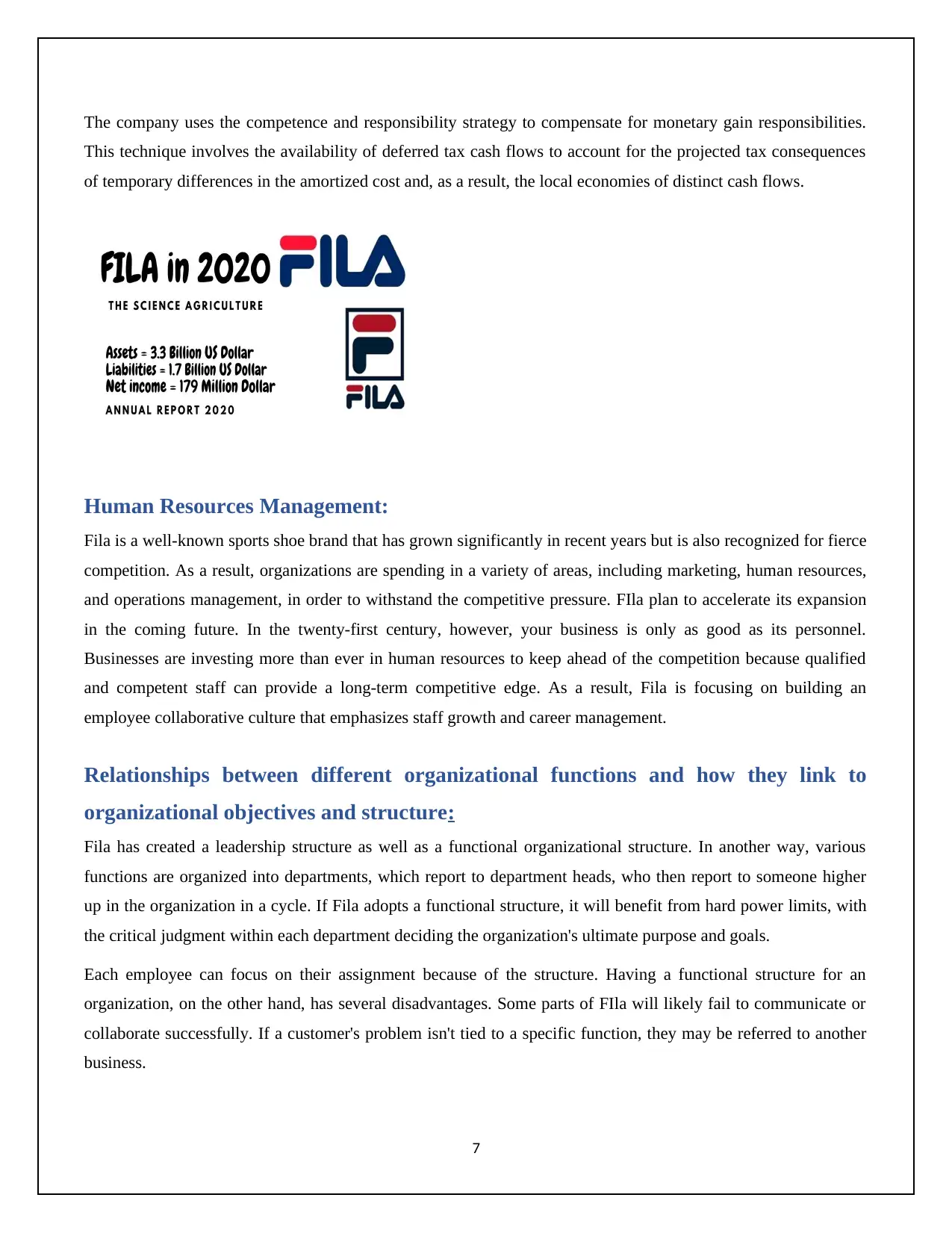
The company uses the competence and responsibility strategy to compensate for monetary gain responsibilities.
This technique involves the availability of deferred tax cash flows to account for the projected tax consequences
of temporary differences in the amortized cost and, as a result, the local economies of distinct cash flows.
Human Resources Management:
Fila is a well-known sports shoe brand that has grown significantly in recent years but is also recognized for fierce
competition. As a result, organizations are spending in a variety of areas, including marketing, human resources,
and operations management, in order to withstand the competitive pressure. FIla plan to accelerate its expansion
in the coming future. In the twenty-first century, however, your business is only as good as its personnel.
Businesses are investing more than ever in human resources to keep ahead of the competition because qualified
and competent staff can provide a long-term competitive edge. As a result, Fila is focusing on building an
employee collaborative culture that emphasizes staff growth and career management.
Relationships between different organizational functions and how they link to
organizational objectives and structure:
Fila has created a leadership structure as well as a functional organizational structure. In another way, various
functions are organized into departments, which report to department heads, who then report to someone higher
up in the organization in a cycle. If Fila adopts a functional structure, it will benefit from hard power limits, with
the critical judgment within each department deciding the organization's ultimate purpose and goals.
Each employee can focus on their assignment because of the structure. Having a functional structure for an
organization, on the other hand, has several disadvantages. Some parts of FIla will likely fail to communicate or
collaborate successfully. If a customer's problem isn't tied to a specific function, they may be referred to another
business.
7
This technique involves the availability of deferred tax cash flows to account for the projected tax consequences
of temporary differences in the amortized cost and, as a result, the local economies of distinct cash flows.
Human Resources Management:
Fila is a well-known sports shoe brand that has grown significantly in recent years but is also recognized for fierce
competition. As a result, organizations are spending in a variety of areas, including marketing, human resources,
and operations management, in order to withstand the competitive pressure. FIla plan to accelerate its expansion
in the coming future. In the twenty-first century, however, your business is only as good as its personnel.
Businesses are investing more than ever in human resources to keep ahead of the competition because qualified
and competent staff can provide a long-term competitive edge. As a result, Fila is focusing on building an
employee collaborative culture that emphasizes staff growth and career management.
Relationships between different organizational functions and how they link to
organizational objectives and structure:
Fila has created a leadership structure as well as a functional organizational structure. In another way, various
functions are organized into departments, which report to department heads, who then report to someone higher
up in the organization in a cycle. If Fila adopts a functional structure, it will benefit from hard power limits, with
the critical judgment within each department deciding the organization's ultimate purpose and goals.
Each employee can focus on their assignment because of the structure. Having a functional structure for an
organization, on the other hand, has several disadvantages. Some parts of FIla will likely fail to communicate or
collaborate successfully. If a customer's problem isn't tied to a specific function, they may be referred to another
business.
7
Paraphrase This Document
Need a fresh take? Get an instant paraphrase of this document with our AI Paraphraser
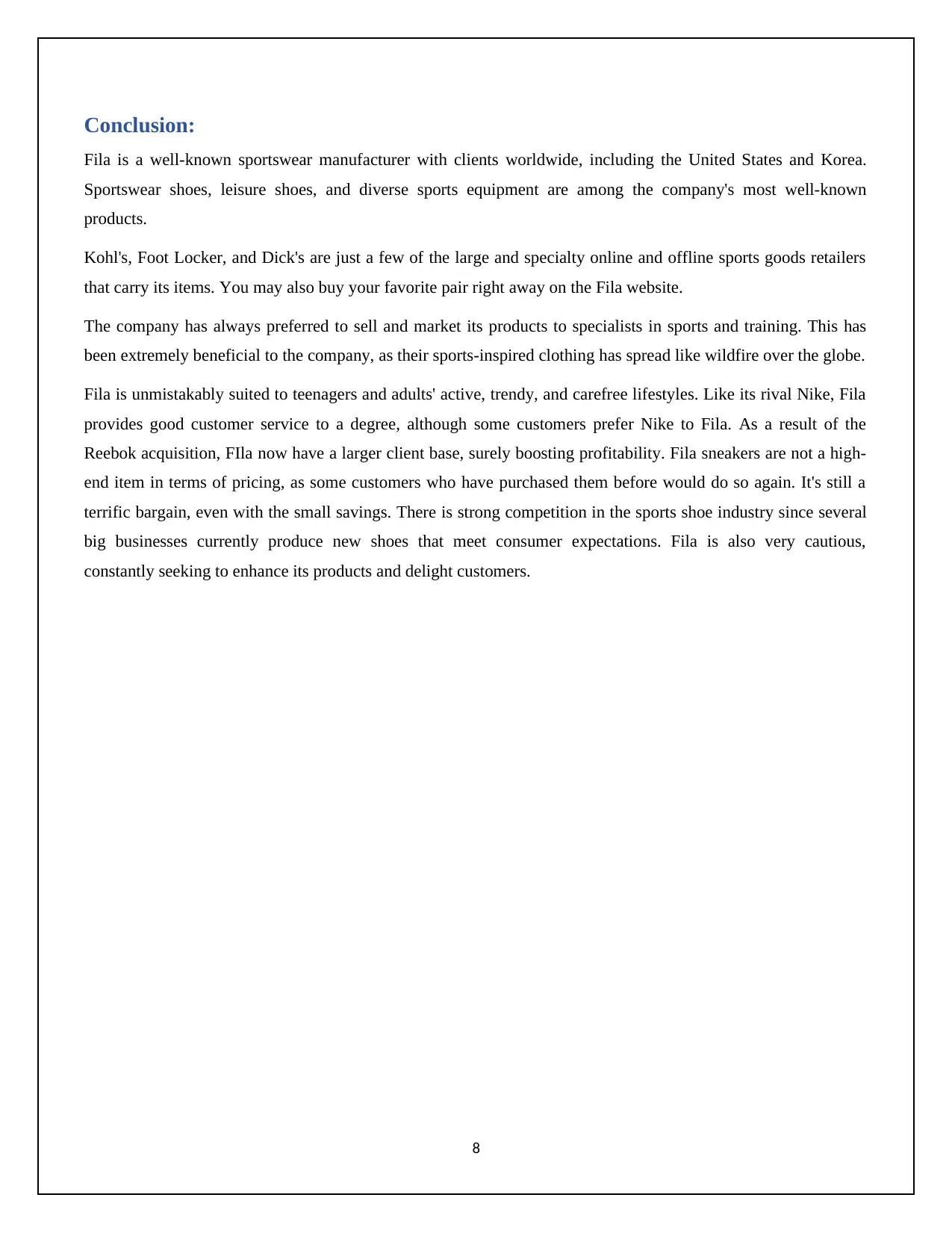
Conclusion:
Fila is a well-known sportswear manufacturer with clients worldwide, including the United States and Korea.
Sportswear shoes, leisure shoes, and diverse sports equipment are among the company's most well-known
products.
Kohl's, Foot Locker, and Dick's are just a few of the large and specialty online and offline sports goods retailers
that carry its items. You may also buy your favorite pair right away on the Fila website.
The company has always preferred to sell and market its products to specialists in sports and training. This has
been extremely beneficial to the company, as their sports-inspired clothing has spread like wildfire over the globe.
Fila is unmistakably suited to teenagers and adults' active, trendy, and carefree lifestyles. Like its rival Nike, Fila
provides good customer service to a degree, although some customers prefer Nike to Fila. As a result of the
Reebok acquisition, FIla now have a larger client base, surely boosting profitability. Fila sneakers are not a high-
end item in terms of pricing, as some customers who have purchased them before would do so again. It's still a
terrific bargain, even with the small savings. There is strong competition in the sports shoe industry since several
big businesses currently produce new shoes that meet consumer expectations. Fila is also very cautious,
constantly seeking to enhance its products and delight customers.
8
Fila is a well-known sportswear manufacturer with clients worldwide, including the United States and Korea.
Sportswear shoes, leisure shoes, and diverse sports equipment are among the company's most well-known
products.
Kohl's, Foot Locker, and Dick's are just a few of the large and specialty online and offline sports goods retailers
that carry its items. You may also buy your favorite pair right away on the Fila website.
The company has always preferred to sell and market its products to specialists in sports and training. This has
been extremely beneficial to the company, as their sports-inspired clothing has spread like wildfire over the globe.
Fila is unmistakably suited to teenagers and adults' active, trendy, and carefree lifestyles. Like its rival Nike, Fila
provides good customer service to a degree, although some customers prefer Nike to Fila. As a result of the
Reebok acquisition, FIla now have a larger client base, surely boosting profitability. Fila sneakers are not a high-
end item in terms of pricing, as some customers who have purchased them before would do so again. It's still a
terrific bargain, even with the small savings. There is strong competition in the sports shoe industry since several
big businesses currently produce new shoes that meet consumer expectations. Fila is also very cautious,
constantly seeking to enhance its products and delight customers.
8
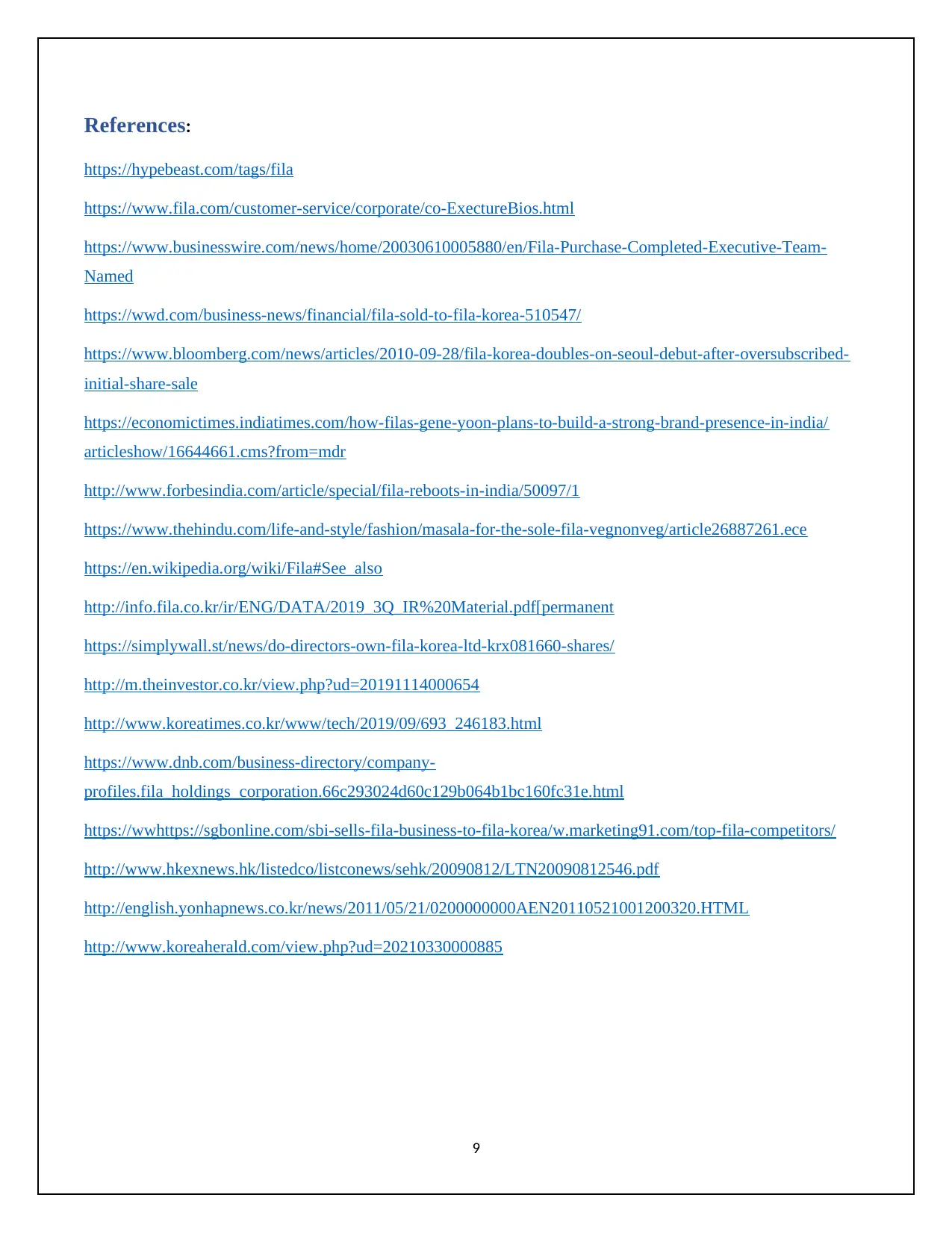
References:
https://hypebeast.com/tags/fila
https://www.fila.com/customer-service/corporate/co-ExectureBios.html
https://www.businesswire.com/news/home/20030610005880/en/Fila-Purchase-Completed-Executive-Team-
Named
https://wwd.com/business-news/financial/fila-sold-to-fila-korea-510547/
https://www.bloomberg.com/news/articles/2010-09-28/fila-korea-doubles-on-seoul-debut-after-oversubscribed-
initial-share-sale
https://economictimes.indiatimes.com/how-filas-gene-yoon-plans-to-build-a-strong-brand-presence-in-india/
articleshow/16644661.cms?from=mdr
http://www.forbesindia.com/article/special/fila-reboots-in-india/50097/1
https://www.thehindu.com/life-and-style/fashion/masala-for-the-sole-fila-vegnonveg/article26887261.ece
https://en.wikipedia.org/wiki/Fila#See_also
http://info.fila.co.kr/ir/ENG/DATA/2019_3Q_IR%20Material.pdf[permanent
https://simplywall.st/news/do-directors-own-fila-korea-ltd-krx081660-shares/
http://m.theinvestor.co.kr/view.php?ud=20191114000654
http://www.koreatimes.co.kr/www/tech/2019/09/693_246183.html
https://www.dnb.com/business-directory/company-
profiles.fila_holdings_corporation.66c293024d60c129b064b1bc160fc31e.html
https://wwhttps://sgbonline.com/sbi-sells-fila-business-to-fila-korea/w.marketing91.com/top-fila-competitors/
http://www.hkexnews.hk/listedco/listconews/sehk/20090812/LTN20090812546.pdf
http://english.yonhapnews.co.kr/news/2011/05/21/0200000000AEN20110521001200320.HTML
http://www.koreaherald.com/view.php?ud=20210330000885
9
https://hypebeast.com/tags/fila
https://www.fila.com/customer-service/corporate/co-ExectureBios.html
https://www.businesswire.com/news/home/20030610005880/en/Fila-Purchase-Completed-Executive-Team-
Named
https://wwd.com/business-news/financial/fila-sold-to-fila-korea-510547/
https://www.bloomberg.com/news/articles/2010-09-28/fila-korea-doubles-on-seoul-debut-after-oversubscribed-
initial-share-sale
https://economictimes.indiatimes.com/how-filas-gene-yoon-plans-to-build-a-strong-brand-presence-in-india/
articleshow/16644661.cms?from=mdr
http://www.forbesindia.com/article/special/fila-reboots-in-india/50097/1
https://www.thehindu.com/life-and-style/fashion/masala-for-the-sole-fila-vegnonveg/article26887261.ece
https://en.wikipedia.org/wiki/Fila#See_also
http://info.fila.co.kr/ir/ENG/DATA/2019_3Q_IR%20Material.pdf[permanent
https://simplywall.st/news/do-directors-own-fila-korea-ltd-krx081660-shares/
http://m.theinvestor.co.kr/view.php?ud=20191114000654
http://www.koreatimes.co.kr/www/tech/2019/09/693_246183.html
https://www.dnb.com/business-directory/company-
profiles.fila_holdings_corporation.66c293024d60c129b064b1bc160fc31e.html
https://wwhttps://sgbonline.com/sbi-sells-fila-business-to-fila-korea/w.marketing91.com/top-fila-competitors/
http://www.hkexnews.hk/listedco/listconews/sehk/20090812/LTN20090812546.pdf
http://english.yonhapnews.co.kr/news/2011/05/21/0200000000AEN20110521001200320.HTML
http://www.koreaherald.com/view.php?ud=20210330000885
9
⊘ This is a preview!⊘
Do you want full access?
Subscribe today to unlock all pages.

Trusted by 1+ million students worldwide
1 out of 9
Your All-in-One AI-Powered Toolkit for Academic Success.
+13062052269
info@desklib.com
Available 24*7 on WhatsApp / Email
![[object Object]](/_next/static/media/star-bottom.7253800d.svg)
Unlock your academic potential
Copyright © 2020–2025 A2Z Services. All Rights Reserved. Developed and managed by ZUCOL.